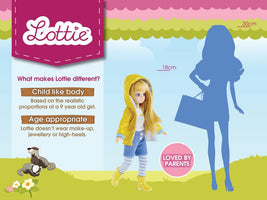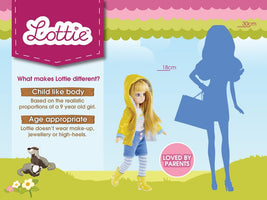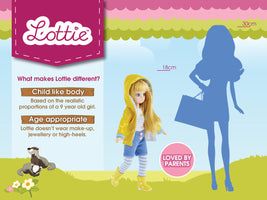Toymakers should stop making ultra-thin dolls, because they create poor body image in young girls which can lead to eating disorders.
Lottie Dolls body-realistic dolls were part of a recent UK study that found playing with ultra-thin dolls makes girls aged 5-9 want a thinner body or “ideal size”. In contrast, the study found that playing with realistic children’s dolls, like Lottie, did not adversely affect the girls’ body ideals.
However, if girls played with the ultra-thin dolls before the realistic dolls, their ideal body size remained thinner.
This shows that you cannot immediately counteract the effects of playing with ultra-thin dolls by playing with other toys. So, the best way to protect girls’ wellbeing is to stop making skinny dolls.
The study, published in the academic journal Body Image, was conducted by researchers from Durham University, Newcastle University and Northumbria University. The research was conducted independently from doll manufacturers.
The research was led by Durham University Psychologist, Professor Lynda Boothroyd. In an official statement released this morning, Dr Boothroyd said body dissatisfaction “is a huge problem, particularly amongst young girls. It can have serious consequences for girls’ wellbeing and lead to eating disorders and depression.”
This latest study is “the most comprehensive report to date on the impact of skinny dolls on girl’s perception of their own body shape. It’s time for manufacturers, retailers, toy associations and toy awards to take positive action and stop promoting dolls with unrealistic body shapes in the market. Toy industry professionals have read these reports but continue to ignore the findings.
Alarmingly, 95% of the dolls that parents can actually purchase online or in stores are the ultra-thin type. It’s hard for parents to refuse them when they are heavily marketed directly to young girls.
Toy manufacturers are missing out on an opportunity to develop empathy in kids. “Instead of teaching kids they all need to look the same, why not teach them to embrace who they are, and include other kids instead? We develop dolls with diverse skin colours, body sizes, and abilities, precisely because we want to promote positive self-image, and instil values of kindness and inclusivity.”
Study Source Information
Can realistic dolls protect body satisfaction in young girls? Boothroyd et al, published in Body Image by Elsevier on 11 March 2021.
A copy of this paper is available on request from Durham University Marketing and Communications Office on communications.team@durham.ac.uk
Professor Lynda Boothroyd, from Durham University’s Department of Psychology, is available for interviews on Wednesday 10 March and Thursday 11 March.
For interview requests, please contact Lynda Boothroyd l.g.boothroyd@durham.ac.uk or Durham University’s Marketing and Communications Office on communications.team@durham.ac.uk
![]() Fast Shipping
Fast Shipping![]() Subscribe to our Newsletter
Subscribe to our Newsletter![]() 🌟 New Global Competition 🌟
🌟 New Global Competition 🌟














